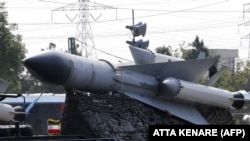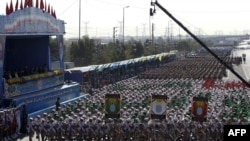The Institute for International Strategic Studies has published an analysis of Iran's 2018-19 budget suggesting an "upward trajectory" for Iran's defense spending.
The London-based IISS also highlighted essential changes in the way resources are being allocated to Iran's military budget. The study confirms earlier reports and analyses that said the Islamic Republic was strengthening its security forces and religious institutions that constitutes the two pillars of the regime.
An 84% rise in the budget allocated to Iran's police force and the controversial rise in the budget of numerous religious institutions, that do nothing but trumpeting Tehran's Islamic ideology and training clerics, are examples of the way the government “mishandles” the country's resources, according to critics. Even regime insiders protested to these excessive fund allocations.
During protest demonstrations since December 2017, massive groups of underprivileged Iranians including industrial workers, truckers and teachers protested against the increased spending on security forces and regional military ambitions, and proliferation of hardline religious institutions who received hundreds of millions of dollars to such institutions in the annual budget.
Throughout 2018, in many protests, people chanted slogans against Iran's military presence in Syria and called for a secular democracy rather than a religious dictatorship.
The Islamic Republic of Iran's military budget and its resources are always shrouded in ambiguity. Apart from what is presented to the Parliament within the frameworks of the country's annual budget, it has some secret layers military analysts and economists have always wanted to explore.
In February 2018 MP Mohammad Reza Badamchi said that the legislature votes only for thirty percent of the national budget and it has no chance to vote for the rest. He tweeted, “The public should know that only one-third of the country’s budget is discussed in parliament; which is mainly the part about government’s income and [operational] expenses.” The other seventy percent involves the income and expenditures of state owned enterprises, for-profit companies and banks.
Maintaining that the Iranian annual budget simply presents a snapshot of the official and evident expenditure of the country, the IISS report by Jennifer Chandler says most organizations, particularly the armed forces have access to financial resources outside of the country's annual budget that enables them to increase the funds available to them.
These extra-budgetary funds includes revenues from domestic oil sales. Meanwhile, "The Islamic Revolutionary Guard Corps (IRGC) engages in aggressive revenue-raising activities by establishing private companies, as well as using its powerful political influence to secure infrastructure contracts and private tenders worth millions of dollars in diverse sectors, including housing development, energy, road construction, food and transportation," the IISS report observed.
The IRGC is seriously active in operating private companies all over the country in order to accumulate financial resources. At the same time, IRGC has used its extraordinary influence to win major contracts in various sectors of the economy such as construction, energy, roads, transportation and foodstuff.
"An analysis of the Iranian budget should go beyond examining outlays for Iran’s regular forces (Artesh), the IRGC and the Basij militia. Any calculation of Iran’s defence spending should also take into account Iran’s police force (the Law Enforcement Force, or LEF), armed-forces welfare, and the numerous ideological training and defence-research facilities and universities focused on cultivating suitably ‘islamicized’ personnel to serve both of Iran’s military forces and developing strategy," the IISS observed.
The IISS report is consistent with the findings of Iranian analyst, including Radio Farda's Morad Veisi who, while explaining the expansion of IRGC Intelligence Organization and the expansion of its media outlet, observed that in the latest annual budget there was "non-official financing for non-uniformed regime supporter groups. Their budget remains hidden in appropriations for official organs, such as intelligence organizations and the IRGC. The state also provides a variety of financial support mechanisms for loyal groups, some from religious institutions and mosques."
The IISS report also observed that "The budget process in Iran is deliberately obscure, since with greater transparency comes greater accountability," adding that budget planning in Iran is the outcome of factional power brokering. Thus, "The ability to commandeer a share of the defence budget should be seen as a barometer for the level of influence or lack thereof of different bodies and institutions."
However, despite these challenges, the in-depth study of Iran’s latest annual budget bill covering the period between March 21, 2018 to March 21, reveals five key takeaways.
First, the defense sector's share of official spending is higher than any estimate. Out of an annual budget of 12 quadrillion rials (260 billion dollars based on official exchange rate) some 7.5% is allocated to defense. This comes while IRGC-affiliated media and senior military and defence figures as well as hawks within the Iranian parliament have demanded only 5% of the annual budget for defense. "Yet when combining all aspects of defence spending as mentioned above, Iran’s total military expenditure is estimated at 921 trillion rials (US$19.6 billion)," the IISS report observed.
Second, because of the sharp devaluation of the Iranian currency during the year in question, "defence spending in dollar terms decreased from US$21.4bn to US$19.6bn in just six months." The report concludes that "when measured in real-terms, Iran’s military expenditure is still 53% higher in 2018 than it was five years ago."
Third, the new budget allocated to the IRGC's Khatam al-Anbiya Central Headquarters (CHQ) is the latest sign of the rising profile of this body, which undertakes major development projects in Iran and the Middle East and maintains close links to IRGC Qods Force Commander Qasem Soleimani.
Fourth, the defense budget for the year, shows an 84% for the Law Enforcement Force (LEF), which is the official name for Iran's police. This could be a response to several major nationwide anti-government demonstrations throughout the year.
Fifth, in July 2017, the parliament set out funding for the Quds Force and the missile program, amounting to 10 trillion rial (US$213m) each. However, these extra-budgetary fundings were not included in the 2018–19 defence-budget bill.
According to the IISS, these initial findings support the contention that important changes are under way in the level of resources Iran is devoting to its military ambitions.







